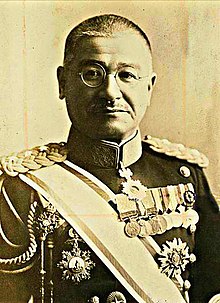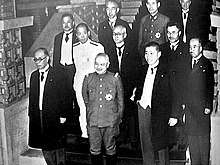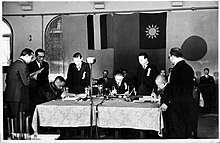Nobuyuki Abe
General Nobuyuki Abe[1] (阿部 信行, Abe Nobuyuki, November 24, 1875 – 7 September 1953) was a general in the Imperial Japanese Army, Governor-General of Korea, and Prime Minister of Japan.
Nobuyuki Abe | |
|---|---|
阿部 信行 | |
 | |
| Prime Minister of Japan | |
| In office 30 August 1939 – 16 January 1940 | |
| Monarch | Shōwa |
| Preceded by | Kiichirō Hiranuma |
| Succeeded by | Mitsumasa Yonai |
| Minister of Foreign Affairs Empire of Japan | |
| In office January 1939 – August 1939 | |
| Monarch | Shōwa |
| Preceded by | Hachirō Arita |
| Succeeded by | Kichisaburō Nomura |
| Governor General of Korea Empire of Japan | |
| In office 22 July 1944 – 12 September 1945 | |
| Monarch | Shōwa |
| Preceded by | Kuniaki Koiso |
| Succeeded by | Kim Il-Sung (as Premier of North Korea) Syngman Rhee (as President of South Korea) |
| Personal details | |
| Born | 24 November 1875 Kanazawa, Japan |
| Died | 7 September 1953 (aged 77) |
| Political party | Taisei Yokusankai (1940–1945) |
| Other political affiliations | Independent (Before 1940) |
| Alma mater | Imperial Japanese Army Academy Army War College |
| Profession | General |
Early life and military career
Abe was born into an ex-samurai family in Kanazawa city, Ishikawa Prefecture. His brother-in-law was Imperial Japanese Navy admiral Shigeyoshi Inoue.
Abe attended Tokyo No.1 Middle School (Tokyo Metropolitan Hibiya High School) followed by No.4 High School. While still a student, he volunteered for military service during the First Sino-Japanese War.
After the war, Abe graduated from the Imperial Japanese Army Academy in November 1897. Commissioned a second lieutenant the following 27 June, he was promoted to lieutenant in November 1900 and attended the Army Artillery School, graduating in December 1901. Promoted to captain in November 1903, he enrolled in the 19th class of the Army War College, graduating in November 1907. Ultranationalist General Araki Sadao was one of his classmates. He was promoted to major in December 1908, becoming an instructor at the Army War College in September 1909. In November 1910, he was posted to the German Empire as a military attache' at the Japanese embassy, and became a supplementary attaché at the embassy in Vienna in February 1913.
Abe was promoted to lieutenant colonel in February 1915, and to colonel on 24 July 1918. He served as the commander of the 3rd Field Artillery Regiment from 1918–1921. In August 1918, his regiment was sent to Siberia during Japan's Siberian Intervention, but never saw combat. He became secretary of the Army War College on 3 June 1921, and was promoted to major general on 15 August 1922. Appointed Director of the General Affairs Division of the Imperial General Staff on 6 August 1923, following the devastating earthquake of 1 September, he was placed in charge of overseeing martial law for the Kanto region on 3 September.
He was appointed director of military service affairs in the Army Ministry on 28 July 1926, and was promoted to lieutenant general on 5 March 1927. He later served as chief of the Military Affairs Bureau and as Vice Minister of the Army, which he had been appointed as on 10 August 1928. He commanded the 4th Infantry Division from 22 December 1930.
In January 1932, Abe was appointed to command the Japanese Taiwan Army, and he was promoted to full general on 19 June 1933. After serving on the Supreme War Council, he was placed on the reserve list on 10 March 1936.
As Prime Minister

Abe Nobuyuki was not the obvious first choice as Prime Minister after the collapse of the Hiranuma Kiichirō cabinet. From the civilian side, Konoe Fumimaro or Hirota Kōki were regarded as front-runners; however the Army and the ultranationalists strongly supported General Ugaki Kazushige. After genrō Saionji Kinmochi declared his lack of enthusiasm for any of those candidates, the Army was poised to have its way. However, Ugaki fell ill and was hospitalized. The interim War Minister General Abe was a compromise choice. He had the advantage of belonging to neither the Tōseiha nor the Kodoha political factions within the Army and was also supported as a relative political moderate by the Imperial Japanese Navy; on the other hand he was despised by many senior Army officers for his total lack of any combat experience.
Abe became Prime Minister on 30 August 1939.[2] He concurrently held the portfolio of Foreign Minister. During a reign which lasted only four months, Abe sought to end as quickly as possible the Second Sino-Japanese War, and to maintain Japan's neutrality in the growing European conflict. He was also opposed to efforts by elements within the Army to form a political-military alliance with Nazi Germany and Fascist Italy. Increasingly lacking in support from either the military or the political parties, Abe was replaced by Mitsumasa Yonai in January 1940.
Subsequent career

Three months later after his replacement as Prime Minister, Abe was sent by the army as a special envoy to China to advise the Japanese-supported regime of Wang Jingwei in Nanjing, and to negotiate a treaty ensuring Japanese economic and military rights in northern China. However, he did have some sympathy for Wang Jingwei's pro-Japanese "reorganized national government" of China. He remained as the Japanese ambassador to China in Nanjing until 1941. After his return to Japan, Abe joined the House of Peers in 1942, and accepted the largely ceremonial position as president of the Imperial Rule Assistance Political Association. He was appointed the 10th (and last) Governor-General of Korea in 1944 and 1945.
Following World War II, Abe was purged from public office, and arrested by the American occupation government. However, he was not charged with any war crimes and was soon released. His second son was Nobuhiro Abe.
Honours
- Grand Cordon of the Order of the Sacred Treasure (November 1930)
- Grand Cordon of the Order of the Rising Sun (April 1934)
References
Books
- Barnhart, Michael (1988). Japan Prepares for Total War: The Search for Economic Security, 1919–1941. Cornell University Press. ISBN 0-8014-9529-6.
- Bix, Herbert P. (2001). Hirohito and the Making of Modern Japan. Harper Perennial. ISBN 0-06-093130-2.
- Coox, Alvin D. (1990). Nomonhan: Japan Against Russia, 1939. Stanford University Press. ISBN 0-8047-1835-0.
- Baudot, Marcel (1988). The Historical Encyclopedia or World War II. Facts on File Inc. ISBN 0-87196-401-5.
| Wikimedia Commons has media related to Nobuyuki Abe. |
External links
- Ammentorp, Steen. "Generals from Japan: Abe, Hiroaki". The Generals of World War II. Retrieved 2007-09-03.
- Newspaper clippings about Nobuyuki Abe in the 20th Century Press Archives of the ZBW
Notes
- The script Noboyuki is also found
- Baudot, Marcel (1980). The Historical Encyclopedia or World War II. Facts on File Inc. pp. 1. ISBN 0-87196-401-5.
| Political offices | ||
|---|---|---|
| Preceded by Hachirō Arita |
Minister of Foreign Affairs 1939 |
Succeeded by Kichisaburō Nomura |
| Preceded by Kiichirō Hiranuma |
Prime Minister of Japan 1939–1940 |
Succeeded by Mitsumasa Yonai |
| Preceded by Kuniaki Koiso |
Governor General of Korea 1944–1945 |
Position abolished |